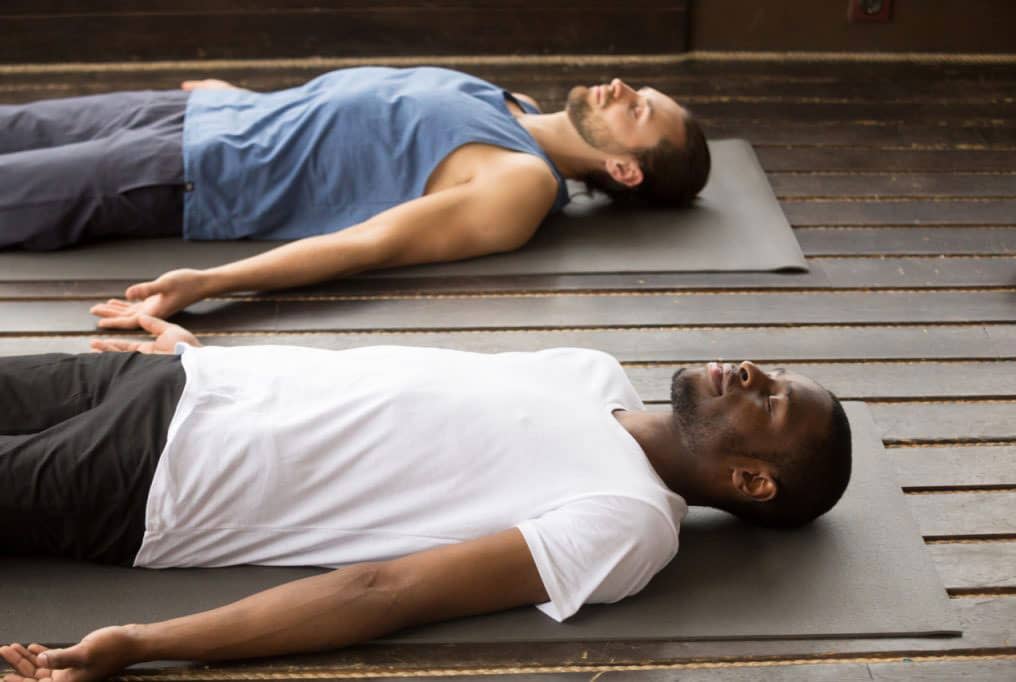Quick Guide: 8 Yoga Practices A Couple Can Do Together

The practice of yoga is an excellent way to exercise for couples in all the colors of the rainbow flag. For gay partners who are in a long-term relationship or married together, doing yoga can have a lot of benefits and may even be more beneficial to the practice than doing it alone. Not only does practicing with a partner make the exercise of yoga more enjoyable to do, but it also makes it possible for you and your partner to execute complex maneuvers in yoga that cannot be accomplished by a single individual. If you want to learn more about these yoga techniques and practices for you and your partner, continue reading and find out!
Why Is Yoga Good For Couples?
For gay couples, petty quarrels can get really heated. If you have time to spend together, you need to take the opportunity to release some tension. The practice of couple yoga can surely help as it is very intimate, peaceful, and engaging. The calm and graceful actions of yoga can relieve stress and can transport the practitioner’s mind to make a better environment, even when the home is situated in the middle of a busy city. Yoga is beneficial for couples and those who are already stressed out about the mundane task of everyday life. It helps you forget the hectic experiences you face and makes you feel better and calmer in an intimate shared atmosphere. So what other benefits can you get when you do yoga as a couple?
The Different Benefits Of Yoga For Couples
Couples’ yoga is an intimate practice that helps strengthen a relationship. The reason being is that yoga is an exercise that requires individuals to work together in a synchronized fashion. Yoga also promotes exercising in a peaceful space where your minds and bodies are free. It also removes the distractions to make meaningful quality time spent. Yoga is a positive exercise that promotes the release of negativity and judgment. Here are three reasons why yoga benefits a couple.
1. Improves trust and communication.
Communication is key when practicing yoga with your partner. The practice of yoga can increase openness by constantly communicating verbal and non-verbal cues. Through verbal communication, the right timing and movements are initiated in the practice. Couples can also benefit from hearing the voice of the partner working together to achieve a goal.
Non-verbal cues in yoga are seen in physical touch when initiating maneuvers. Through physical touch, a partner can feel the sense of being loved, appreciated, valued and the feeling of being safe with your partner. In the process, the couple will build trust, where support and vulnerability are present.
2. Develops deeper intimacy in couples.
Because the practice of couples yoga requires communication and trust, there is a deeper connection that can be established. This deeper connection is present in the form of spiritual enlightenment for the couple, from being in sync in movement and breathing. Intimacy builds up eventually when you pair this connection with physical touches from the different yoga techniques.
3. Releases stress and anxiety
It is known that yoga as a practice can decrease stress levels and anxiety by releasing tension in a peaceful environment. Practicing yoga with your significant other proves to be way more beneficial because it involves physical touch. A simple caress or being secured with your partner while initiating techniques can work wonders in creating a safe environment in your head. The feeling of being safe can significantly decrease anxiety levels in a person.
8 Yoga Techniques That Gay Couples Can Do Together
Facing Twist
- This technique requires both partners to face each other and by sitting straight with both legs crossed.
- Reach out to your partner’s waist with your right hand while you stretch your left hand behind your back.
- Hold your partner’s right hand with your left and vice versa.
Note: Be careful when initiating this technique since your pull will influence how far your partner’s back will twist.
- Gently take turns twisting each other’s back and make sure that you accompany it with steady breathing.
Seated Centering/Grounding
Note: This technique is aimed towards meditation.
- Face each other while sitting straight with both of your legs crossed.
- Look into your partner’s eyes and take 10-15 deep breaths.
- With every breath, connect with your partner on a deeper level without saying a word.
- A helpful tip is to try to communicate using the mind.
Boat Pose
- While seated and facing one another, reach out to your partner’s arms and have a firm grip just above the wrist.
- Bend your knees and touch your partner’s toes.
Note: Take your time doing this since this may not be a good technique to rush into.
- Once your legs are straight, hold the final position for 5-10 seconds accompanied with calm breathing and slowly release back down.
Wide-Legged Forward Bend
- While seated comfortably and facing each other, both partners spread their legs and have their toes touch.
- One person will then start to extend their arms towards your waist until the back is fully folded.
- The other person can help by pushing down on the partner’s back gently to reach a good stretch.
- Take several breaths while folded in this position before returning to the seated position.
- Take turns.
Temple Pose
- Face your partner in a standing posting.
- With your feet wide apart, slowly extend the arms over your head while bending your knees toward your partner.
- Once your arms hands touch, begin to fold your hands, elbows, and forearms to rest on the other.
Note: The goal is to lean on each other’s weight and balance in place while your body is facing down.
- Hold this position for 5-10 breaths before coming slowly rising back to the center.
Standing Forward Fold
- Begin this technique by facing away from your partner.
- You must be at least six inches apart.
- Stay still and fold forward. The goal is to reach your partner’s shins.
- Both should be holding each partner’s shin for five breaths before going back to the center.
Seated Forward Bend
- While seated and facing each other, touch toes. Your knees can be slightly bent for this technique.
- Reach for your partner’s arms get a solid grip just above the wrist.
- Allow your partner to bend towards you while you help pull them in gently slightly. Do this until there is tension and hold for 5-10 breaths.
- Release and take turns.
Double Camel Pose
- Start this technique on your knees and facing away from each other.
- By doing a backbend, rest your head on your partner’s shoulder.
- Once in a comfortable position, support one another and hold the position for 10-15 breaths.
Conclusion
Yoga is a practice known to help the mind, body, and spirit of an individual. It is ideal for exercising yoga with your partner to help develop these traits together. Yoga promotes intimacy and can strengthen any relationship. For those couples who want to find a deeper connection while promoting physical health, couples yoga is something you must try.
